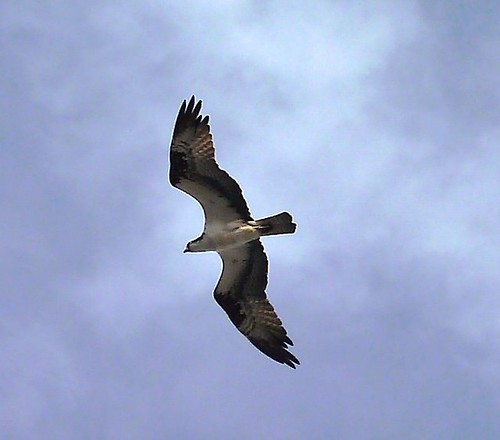Keep an eye on the sky around the Hill, and you might see flying sea hawks—not the football players, but the birds that gave their team its name. They’re more commonly called by another name: osprey.
The osprey is a large hawk with a white head and a bold brown or black stripe along the eye. The underside is mostly white, and the wings and back are mostly brown. Ospreys often fly with their wings kinked a bit in the middle, which gives them a distinctive M shape.
Ospreys survive almost exclusively on live fish. They can’t dive more than about a meter underwater, so they tend to hunt in the shallows, although they may also take fish that swim near the surface of deeper water. Their hunting behavior is highly unusual: they dive headfirst toward the water and, at the last moment, throw their feet forward to grasp the fish below the surface.
When actively at work hunting, Ospreys tend to make a successful catch about once every 12 minutes—a success rate that makes many human anglers jealous. Ospreys have an unusual reversible front claw, which allows them to grip still-living fish with two claws in front and two in back. This prevents them from losing prey on the way back to a perch, although a bald eagle may swoop in and grabs the fish before the osprey can eat it.
Ospreys, like eagles, are a conservation success story. In the mid-20th century, their numbers declined rapidly due to pollution, especially from DDT. Between 1950 and 1970, they seemed on the path to extinction. Studies found a decrease of 90% in the numbers of nesting osprey pairs in the New York to Boston region during that period.
However, cleanup projects, pollution controls, and the ban on DDT seem to have been enough to save ospreys. When their environment is clean enough, these hawks are remarkably tolerant of human neighbors. In some areas, 90-95% of them choose manmade nest sites such as power poles, even when natural nest sites such as trees and cliff ledges are available.
Ospreys fly over Capitol Hill fairly regularly. If you’d like to see them hunting, head down to Lake Washington or Portage Bay.
Learn more
- Check out the osprey’s page at the Cornell Lab of Ornithology.
- Click here to hear an osprey’s call, which is sometimes compared to the sound of a whistling kettle.
- You can watch a video of ospreys hunting here.
More Capitol Hill Aviary




They are wonderfully adaptive in the choice of nest-sites too, building on cell towers, light standards, and other replacements for the snags and trees that are now hard to find in our human dense environment!
Most of the Osprey have now de-camped, migrating down to Central and South America for the winter, though the odd straggler may still be found. Keep your eyes peeled next spring though….they will be back.
Anne Jacobs